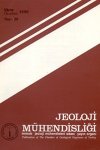
ABSTRACT: Stratigraphie squence of th.e area consist of the Pötürge Metamoxphic in Pie.rmo~!Ca:rbonifer, Maden. Complex In Eocene,, Malatya Metamoiphics im Pe-imo-Carponifer,, Göndûzbey group in C:retaceou.ss Yeşilyuıt group,. Gedik formations in. Eocene, Kilayik and Beyİerderesi formations in Miocene, The occurrence of the springs in the study area are effected by karsttification, karst-fault, boundaûrs of the permable and impeimable rock units an,d faults. Pınarbaşı spring 300 1/s, Horata ` sprâg 9Ö1 1/s and tnekpuian spring 0-30 l/s are. The small springs are changed between 0,52-0,2 1/s. The general chemical classifications of `these springs are as the following: amons rHCQ`j > rQ" > 1SQ4"" and. cations r{Ca+i+` + Mg+ + ) > rNa+ > rK+. According to Piper `these waters are "Alcalie earth. (Ca++ + Mg+ + ) > exveed alcaie elements (Na+ + K+) and "carbsonate hardnees excedds than ^SQ1"; according, to in Schoeller classification are"1` normal chlorine» sulphate (and. carbonate, waters*1; according to Şahinci -these waters are also A-Iab(ba), A j C-Iab(baX AC-Hab(ba) and C2A.-Ha.DCab).. According, to Sar classification the pong waters are `"excellent for irrigation",,, C2-S1 according to1 USA... laboratory salinity diagram is; although in Wilcox diagram arc "excellent to
ABSTRACT : The Kızıldag mineralizations occur within the granite of the Yüksekova. Complex .and are related to the fanltings what generally strike E-W and dip to north.The. mineralizations are either disseminated or1 as fillings of the fault .zones and. the type, of mineralizations are spéculante, pyrite (± chalcopyrite), galena (± sphalerite) and Ce minerals. The. most common mineralizations arc specillariie and pyrite mineralizations what grades: in to each other In. the localities where. Eh was high (above underground water table)"`mineralizations formed as spéculante and where Eh was low (below `UWT) mineralizations took place as pyrite. `The faulting took place doling end of Upper Cretaceous - Palaogene and probably in the same period when the Keban metamorphics thnisted over the Yüksekova. Complex. Although the outcropping parts: of `the mineralizations have no* economic value,, the mineral contents of the zones are likely to grade in to valuable mineral assemblages vertically.
ABSTRACT : Clay mineralsıare determined .and ilite crystallinity degrees arc measured.. Total 25 rock samples picked, up from Kuşça formation .im, Akçakoca, (Bolu) region, which is; in Devonian age. Main, clay minerals determined in this region :illite.t, chllorile and kaolinite., According to the results,. Kuşça, formation Upper Silurian - Lower- Devonian aged., is undergone diagenesis epimetamorphism and andbimetamorphism
ABSTRACT: The limer Anatolian granitoid belt is situated at the western, proximity of the Kırşehir Massif.. Forty samples of Çelebi granitoid, which contantes one of `the intrusions in the belt., were analysed for major and trace elements. The geochemical proper- `lies and the origin of the intrusion -arc discussed. Principal daik colored minerals of the granitoids in dhe area studied which have granitic, granodioritic qiiartzmonzonMc, quartzmonzodioritic composition and! calc-alk aline character, consist of homblend + biotite ± clinopyroxene and titanite.. These- instrosions contain abundant residual rock inclusions of similar minéralogie composition, and are- of I-type granitoid character. They have a high concentration of K.,, Rb, Sr, Ba, Zr, Nb, .Tht U`,, Rb/Sr,. and a low concentration of K/Rb and Sr/B-a.. It can be claimed, that the Çelebi granitoid, which shows similarities to volcanic .arc and post-collision granitoids in terms of the content of certain trace elements,,, is formed through partial melting of the continental crast ± mantel material,, basing on. its imneralogical- petrographical and geochemical properties.
ABSTRACT: There arc five different sedimentary sequences which are differed from each other by disconfonmities,,. in `the study area.. `These are; (1) Late Cretaceous-Paleocene sedimantary sequence, with, out not giving outcrops, at the base and ending regiessively at the top (pelagic Lort. limestone). (2) Early Eocene sedimentary sequence, begining with transgression and, ending with regression, (reclfal. Başoğlu member, flysch feature. Saz member and. .terrestrial Tayfur formation). (3) Mittle-Late Eocene and Oligocène sedimentary sequence oommencing with transgression and ending with, regression (recifal Kozlutepe limestone, flysch feature. Karaağaç member, Kabasal memmer and terrestrial Göksu rn.em.ber), (4) Locally marine and, terrestrial. Middle-Late. Miocene sedimentary sequence (Eceabat formation) and. (5) Terrestrial Late Pliocene sedimentary sequence.. Post Late- Cretaceous-Paleocene and pre-Miocene sedimentary sequence have, `been deposited controlling, with ender the influence of epirogemc events. "The tectonic structures in Early Miocene were formed by compressional forces developed in the south with the widening of Saras Graben.. Geometrical relations among Early Miocene age faults, folds: and. joints; proves, that the region was influence, of compressional force in the NW-SE direction. Middle-Late. Miocene sedimentation are controlled by the. grow up faults
ABSTRACT: Kefdağ ve Soridağ chromilite bodies were occured in cth.e diapiric upper mantle residual peridotite«,. "These are consist of harzburgite and dunite which are residiuals of `the multi stage depleted upper mantle. Kefdağ and Soridağ chromitite bodies, were occured during `the rising of the picritic melts of the fertile I1e.rz0ll.tic origin, through the residual upper mantle diapir along the magma conduits.. ChTomite grains were deposited in the. caves of the magma, conduits under the control of the convection currents..
ABSTRACT : It is widely known liât» Upper Cretaceous .and. Paleocene aged sediments exposed in. the western, part of Poetic Belt were:, in general.,, developed, in a deep-marina environment. To the east,, specially during the Paleocene period, deposiiional conditions were gradually changed in to shallow-marine as has been mentioned by various authors. Although, a similar stioation should toe expected in the north of Göyraik (Bolu), an open (deep?)-marine conditions have been again observed for the Paleooene sequence.

 TMMOB
TMMOB